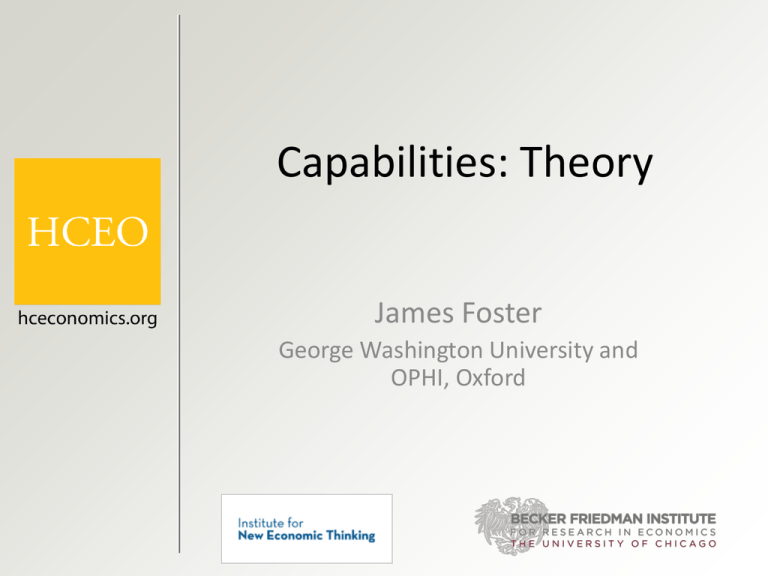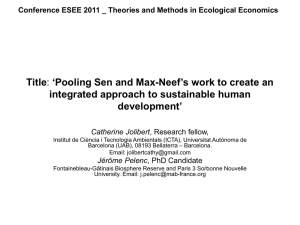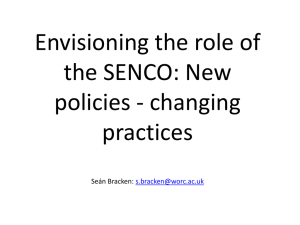
Capabilities: Theory
James Foster
George Washington University and
OPHI, Oxford
Guide
Formalization 28 29 30
Motivation
What is wellbeing?
What is the “right” space for evaluating
inequalities?
Sen’s Answer
Functionings Beings and doings that people value and have
reason to value
Capabilities The collection of functionings available to
people
Motivation
Examples of functionings
Being adequately nourished
Being free from avoidable disease
Being able to take part in the life of the community
Having self-respect
If can represent each functioning by a
continuous variable
Have following graph
from Foster and Sen 1997
Motivation
Capability set and functioning vectors
Motivation
Note the distinction between functionings and
capabilities:
Capabilities reflect one’s freedom to choose valuable
alternatives; what “could be”
Independent of person’s preferences or choice rule
Functionings reflect “what is”
The current achievements of the person
Which may have much or very little to say about other
alternatives (now or in the future)
Ex: Fasting is different from starving in capability, not
functioning
Motivation
Note also that functionings and capabilities (and
the associated freedoms) are
Ends desirable in themselves
Means instrumental for other ends and means
Ex
Being healthy is an end in itself and it helps to
achieve other ends and means
Social interaction is an end in itself and it helps to
achieve other ends and means
Motivation
Wait a minute – why not just use income?
Easy to understand
Easy to measure
Single dimensional
Comparable across people
Underlies most evaluations of wellbeing
Fungible and policy relevant
Motivation
Sen’s answer
Means, not an end
Aristotle: “The life of money-making is one undertaken
under compulsion, and wealth is evidently not the good
we are seeking, for it is merely useful and for the sake of
something else” Nicomachean Ethics
The conversion of means to ends varies dramatically
across persons and groups of persons
Two persons with the same income may have very
different levels of wellbeing if one is very disabled.
Motivation
“The real opportunities that different persons enjoy are very
substantially influenced by variations of individual
circumstances (e.g., age, disability, proneness to illness,
special talents, gender, maternity) and also by disparities in
the natural and the social environment (e.g., epidemiological
conditions, extent of pollution, prevalence of local crime).
Under these circumstances, an exclusive concentration on
inequalities in income distribution cannot be adequate for an
understanding of economic inequality”
Foster and Sen (1997)
Goodbye to the anonymity axiom of income inequality
comparisons
Hello multidimensional inequality (and poverty and wellbeing
analysis)?
Motivation
Why not utility?
Not cardinally measurable
No basis of comparison across persons
Subject to adaptation and other variations
“That’s to say like if you got a cold you take a shot of malaria”
John Birch Paranoid Blues Bob Dylan
Why not the commodity bundle (or budget set)?
Means, and subject to very different conversion
functions
However useful analogy to functioning vector and
capability set
Motivation
There may be other reasons for using
functionings and capabilities
Many key functionings are almost stocks (analogous
to human capital)
May be influenced by current conditions
But largely reflect past investments
And may be more predictive of future prospects
Especially for children
The “pre-distribution” set
Motivation
One could argue that this is the shape of the newest version
of welfare economics
Regularly invoked by Deaton, Heckman, Atkinson, Stiglitz,…
Although Sen regards the capability approach first as framework
for thought, second as a critique of other approaches to welfare
evaluation, and only third as a method of making interpersonal
comparisons of welfare
Robeyns (2000)
Consequently, let’s dive in.
Problem
Like Sen’s Nobel winning work on Social Choice
There are two versions of the same theory – one verbal-descriptive the
other formal-symbolic
Need both
Plan
Review the capability approach
Origins
Definitions
Implications
Explore two extensions
External capabilities
Freedom as flexibility
Discuss applications
Poverty
Robustness
Capability creation
Origins
The capability approach can trace its origins
through the ages and across many countries
Let’s have a quick look round
Sources
Basu and Lopez Calva (2011)
Alkire (2013)
Origins
Aristotle
Politics and Nicomachean Ethics
What should be the aim of public policy?
To provide the conditions that enable people to have a
flourishing life (cf: Bhutan’s GNH)
These conditions help produce the capabilities, or the
possibilities of “functioning in certain human ways”
Which ways?
Nutrition, growth, and other biological ways
Exercising choice and practical reason
Participating in the political life, etc.
What is “the good”?
Where all are able to flourish
Eudaimonia (or makarios)
Egalitarian in space of capabilities
Origins
Marx and Engels
Define a commendable human life:
Material (biological) needs are satisfied
Eating, drinking, dwelling, clothing
Human needs (to exercise reasoning) are satisfied
Correspond to functionings
A liberated society requires freedom in both spheres
Enhanced opportunities in material dimensions
“It is not possible to free men if they cannot be assured access to food, drink,
housing, and good quality-clothing”
Freedom to choose
“…make it possible for me to do one thing to-day and another tomorrow, to hunt
in the morning, fish in the afternoon, rear cattle in the evening, criticize after
dinner, just as I have in mind, without ever becoming hunter, fisherman,
shepherd or critic.”
Corresponding to capabilities.
“Freedom to” rather than “freedom from” Berlin
Origins
Smith
While discussing commodity taxation, defining which commodities are
necessaries and which are luxuries
Emphasizes the instrumental use of commodities in satisfying
material and social needs
By necessaries I understand not only the commodities which are
indispensably necessary for the support of life, but whatever the
custom of the country renders it indecent for creditable people, even
of the lowest order, to be without. A linen shirt, for example, is,
strictly speaking, not a necessary of life. The Greeks and Romans
lived, I suppose, very comfortably though they had no linen. But in
the present times, through the greater part of Europe, a creditable
day-labourer would be ashamed to appear in public without a linen
shirt, the want of which would be supposed to denote that
disgraceful degree of poverty which, it is presumed, nobody can well
fall into without extreme bad conduct.
Origins
Smith
(Continued) Custom, in the same manner, has rendered
leather shoes a necessary of life in England. The poorest
creditable person of either sex would be ashamed to appear in
public without them. In Scotland, custom has rendered them a
necessary of life to the lowest order of men; but not to the
same order of women, who may, without any discredit, walk
about barefooted. In France they are necessaries neither to
men nor to women, the lowest rank of both sexes appearing
there publicly, without any discredit, sometimes in wooden
shoes, and sometimes barefooted. Under necessaries,
therefore, I comprehend not only those things which nature,
but those things which the established rules of decency have
rendered necessary to the lowest rank of people.
Origins
Smith
If commodities are instrumental, what are the
ends?
Human functionings
Including usual basic ones like having enough to eat,
having adequate shelter
But also social interaction, dignity and participation in the
life of the community
Implications: See “Poor, Relatively Speaking” by Sen
Origins
Sen
1980 “Equality of What” Capabilities, given diversity
of people
1983 “Poor, Relatively Speaking” Absolute poverty
standard in capabilities
1984 Commodities and Capabilities Brief and clear
presentation of CA
1992 Inequality Re-examined Summary of work in
context of inequality and poverty – any theory of
justice requires equality in some space – argues for
capabilities as the right space given the diversity of
people
Origins
Sen
1993 Quality of Life (with Nussbaum) outcome of
WIDER project (philosophers and economists)
1999 Development as Freedom synthesis following
Nobel
2009 The Idea of Justice goes beyond capability
approach to discuss principles of justice and processes
Theme: Approach was parallel to and grew out of
applied and policy work: 70’s Basic needs approach, 80’s
growth should be people based, or focused on human
ends, 90’s annual thematic Human Development Reports
by UNDP
Origins
Nussbaum
1990 “Aristotelian Social Democracy”
1993 Quality of Life (Edited with Sen)
1995 Women Culture and Development
2000 Women and Human Development: The Capabilities
Approach
2011 Creating Capabilities
Many other authors
Origins
Nussbaum
Includes list of categories of capabilities
1. Life: not dying prematurely
2. Bodily health: good health; adequately nourished; shelter
3. Bodily integrity; mobility; free from violence; choice in sex and
reproduction
4. Senses, imagination, and thought: education, religion, art
5. Emotions: attachments, love
6. Practical reason: form conception of the good, planning of life
7. Affiliation: social interaction; respect and dignity
8. Other species: concern and relation to animals, plants, nature
9. Play: laugh, play, enjoy recreational activities
10. Control over one’s environment: political participation;
property, employment.
Origins
Sen
Produces no list (reasons)
Critique
Unfinished theory (Romer, Blume)
Sen would argue flexible
This interpretation is empirically validated – many, many
papers are using the approach
Sen would agree that the capability approach is not
a complete theory of justice
Partial and incremental
Capability Approach: Description
We begin with a verbal and graphical description
of the capability approach
Sources
Alkire (2013)
Foster and Sen (1997)
Sen (1999)
Foster and Handy (2008)
Basu and Lopez Calva (2011)
Description
What is it?
Sen’s capability approach is a moral (evaluative, or
normative) framework that proposes that social
arrangements should be primarily evaluated according
to the extent of freedom people have to promote or
achieve functionings they value.
Theme
In many of Sen’s writings, the language is not entirely
self evident; much of understanding Sen is
understanding why the specific language is used.
Description
Capability
• the various combinations of functionings (beings and
doings) that the person can achieve. [It] is, thus, a
set of vectors of functionings, reflecting the person’s
freedom to lead one type of life or another...to
choose from possible livings. (Inequality Reexamined)
• Analogous to a budget set
Description
Capability
• “The focus here is on the freedom that a person
actually has to do this or be that – things that he or
she may value doing or being.” Idea of Justice 232
• Alkire: All formulations of capability have two parts:
freedom and valuable beings and doings
(functionings). Sen’s key contribution has been to
unite the two concepts.
Description
Functionings
The various things a person may value and have
reason to value doing or being
• Intuitive abstract but understandable
• intrinsically valuable to the person not just
instrumental
• intrinsic value (have reason to value) broccoli
• so avoids adaptive preferences on further reflection
would not value
• ‘doings and beings’ is our focal space the space of
human lives
Description
Functionings
Examples
Resources
Capability
Functionings
• Bike
Able to
ride around
Ride around
Cool
• Food
Able to be
nourished
Nourished
Cool
Key Allows for different conversion factors
Utility
Description
Robeyn’s (2005) schematic (with social influences)
Description
Freedom
“the real opportunity that we have to accomplish what we
value”
“The ‘good life’ is partly a life of genuine choice, and not one
in which the person is forced into a particular life – however
rich it might be in other respects.”
It is authentic self-direction – the ability to shape one’s own
destiny as a person and a part of various communities.
Description
Freedom
Not a ‘paper’ freedom: it has to be effective freedom, a real
possibility.
Not maximization of choices without regard to their quality
and people’s values
“Indeed sometimes more freedom of choice can bemuse
and befuddle, and make one’s life more wretched.”
Not necessarily direct control by an individual , groups, states,
etc can increase freedoms by public action and investment.
Description
Freedom has two aspects
Process Aspect:
Ability to act on behalf of
what matters (agency)
Institutions, movements,
democratic practice as
well as each person’s
agency
Opportunity Aspect:
Real opportunity to
achieve valued
functionings, selected
from among various
good possibilities.
(capability)
Description
Agency
“…what a person is free to do and achieve in pursuit of
whatever goals or values he or she regards as
important.”
“…someone who acts and brings about change, and
whose achievements can be judged in terms of her own
values and objectives, whether or not we assess them in
terms of some external criteria as well”
agency is the person’s ability to act on what they value
and have reason to value.
Description
Agency and Capability
“The approach … is essentially a ‘people-centered’ approach, which
puts human agency (rather than organizations such as markets or
governments) at the centre of the stage. The crucial role of social
opportunities is to expand the realm of human agency and
freedom, both as an end in itself and as a means of further
expansion of freedom. The word ‘social’ in the expression ‘social
opportunity’ (…) is a useful reminder not to view individuals and
their opportunities in isolated terms. The options that a person has
depend greatly on relations with others and on what the state and
other institutions do. We shall be particularly concerned with those
opportunities that are strongly influenced by social circumstances
and public policy…” (Drèze & Sen 2002 page 6).
Description
• General Features
– Interactions: Ends and means
– Outside market solutions
– Encourages investments
– Focus on freedoms
– Multidimensional and complex
Description
Misunderstandings
– The breadth goes well beyond health and education
– It is deliberately incomplete – it has to be operationalized
differently in different contexts
– Individualism (is ethical not methodological)
– Evaluative vs Prospective analysis. It can evaluate
activities, or guide policy to create choices.
– Not all multidimensional analyses are capability analyses
•
•
Many don’t consider freedom/agency, intrinsic value, capabilities
not resources, and the process of public debate etc.
Hard to measure freedom, to consider counterfactual options
–
What they could have chosen but didn’t
Capability Approach: Formalization
The approach has been formalized by Sen and
others
We now take a quick look at this version and its
implications
Sources
Sen (commodities and capabilities)
Foster and Sen (1997)
Basu and Lopez Calva (2011)
Formalization
Notation
xi is a vector of commodities for person i
c(xi) is the vector of characteristics from xi
Gorman or Lancaster
fi is i’s personal utilization function
Converting vector of characteristics into vector of functionings
Note: Sen assumes is a choice; we will assume given
bi = fi(c(xi)) is i’s vector of functionings
Xi is the set of vectors of commodities are feasible for i
Qi = { bi such that bi = fi(c(xi)) for some xi in Xi }
Note Many other formalizations possible (social influences, etc)
Formalization
• Motivates interesting empirical issues
– Links across deprivations
• Motivated work on head start
• Education impact health?
– Key
Practical Considerations
Sen suggested that his capability approach could be
applied to evaluate circumstances
However, he was not especially clear how to do so
Let’s briefly explore some practical barriers to using this
approach
Sources
Foster and Sen
Sen Development as Freedom
Foster, MacGillivray, Seth “Robustness”
Allison and Foster
Practical Considerations
Is the theory implementable?
Review of Inequality Re-examined
Main question
Do you have a feasible implementation?
An example where the approach can be applied and
makes a difference
How to measure capabilities, functionings,
freedom?
Practical Considerations
The challenge of measuring freedoms
Freedom has two elements
Agency and empowerment
Broadly configured in Sen’s work
Usually more narrowly confined to personal agency
Opportunity
Range of real opportunities
Both are difficult to infer from observed choices
Without asking, how are we to know the conditions under
which a choice was made?
Without asking, how are we to know the choices that were
not taken?
Practical Considerations
Data on agency?
OPHI questionnaires
Subjective assessments
Women’s Empowerment in Agriculture Index
(discussed later)
Questions on inclusion in decision making
Practical Considerations
Data on opportunities?
Recall budget set
Income and prices are all that is needed to infer the shape and
size of a economic opportunity set
Capability sets
Can observe functionings
But how do we know the shape and size of a capability set?
Direct questions
Inference (need models)
Analogous to inferring treatment effect
Observations over time
Ramadan vs ordinary time
Practical Considerations
Measuring Opportunity Freedom
Several lines of thought in literature (mostly over
abstract sets)
Traditional indirect utility valuation
Sen’s “elementary” evaluation
No value for unchosen options
Pattanaik and Xu
Counting approach
Axiomatically derived
But depends on inability to discern the relative quality of
options
Basically assumes options have value without explaining why
Practical Considerations
Measuring Opportunity Freedom
Kreps (1979), Foster(1993, 2010), Arrow (1995)
Provide answer to why “unchosen” options have
value
Freedom as flexibility
Good choices for every contingency
A kind of options value
Discussed at greater length below
Practical Considerations
How to measure achieved functionings?
Why important?
They miss out on freedom, but:
Functionings describe what is, not what could be
The real conditions people are experiencing
Whether due to their own choice or imposed
Whether a result of an irrational choice mechanism or
mistakes
Agency and opportunity (freedom) also matter, but taking
stock of functionings is very relevant.
Most applications of the capability approach do this
Practical Considerations
Using functionings as a basis
Series of issues noted in Foster and Sen
Many dimensions How to make coherent?
Incompleteness Possible outcome is no evaluation
Weights and measures Deciding on weights
Rank robustness Sensitivity to choice of weights
Foster, MacGillivray, Seth
Practical Considerations
Example 1 Human Development Index
(for countries)
Living standard, education, health
Variables transformed and normalized
Then averaged
Many assumptions and possible criticisms
Inequality Adjusted HDI
Practical Considerations
Example 2 Multidimensional Poverty Index
Alkire-Foster (2011)
Avoids many problems
Of ordinal and incommensurate variables
Etc.
Will discuss later
Capability and Opportunity Freedom
From practical to the theoretical
Q1 How to measure (opportunity) freedom?
Q2 Why should we care about the functionings that are not
chosen?
Start with the simplest of worlds
Functionings are discrete and finite in number
Sources
Pattanaik and Xu (1990)
Sen
Foster (1992, 2011)
Arrow (1995)
Measuring Freedom
Notation
X is the (finite) set of functions or alternative
An opportunity set is a nonempty subset of X
A, B typical sets
Z is the set of all opportunity sets
Goal
Find binary relation R on Z
“Freedom ranking”
A R B “A has at least as much freedom as B”
Measuring Freedom
What assumptions on R?
R is a quasiordering
reflexive and transitive
Note
Completeness not assumed
Associated P and I are transitive
Which R?
Freedom Counts
Candidate 1 Cardinality ranking
Pattanaik and Xu, Suppes, Sugden, others
Define RC by:
A RC B iff |A| > |B|
Measures using number of functionings
Characterized by Pattanaik and Xu
Freedom Counts
Th 1 Cardinality ranking RC is characterized by
three axioms:
S-Strict Monotonicity A B implies A P B when A ≠ B,
A is singleton, and B has two elements
S-Anonymity #A = #B implies A I B when A singleton
S-Independence A R B if and only if (A C) R (B C)
when A C = = B C and C singleton
Freedom Counts
Th 1 Cardinality ranking RC is characterized by
three axioms:
S-Strict Monotonicity A B implies A P B when A ≠ B,
A is singleton, and B has two elements
S-Anonymity #A = #B implies A I B when A singleton
S-Independence A R B if and only if (A C) R (B C)
when A C = = B C and C singleton
Proof: Can drop singleton restrictions, then obv.
Freedom Counts
Th 1 Cardinality ranking RC is characterized by
three axioms:
S-Strict Monotonicity A B implies A P B when A ≠ B,
A is singleton, and B has two elements
S-Anonymity #A = #B implies A I B when A singleton
S-Independence A R B if and only if (A C) R (B C)
when A C = = B C and C singleton
Proof: Can drop singleton restrictions, then obv.
Note RC is extreme. Which axiom is culprit?
Freedom Counts
Th 2 Cardinality ranking RC and trivial ranking RT
are characterized by three axioms:
Monotonicity A B implies A R B
S-Anonymity #A = #B implies A I B when A singleton
S-Independence A R B if and only if (A C) R (B C)
when A C = = B C and C singleton
Freedom Counts
Th 3 Censored cardinality ranking Rk is
characterized by three axioms:
Monotonicity A B implies A R B
S-Anonymity #A = #B implies A I B when A singleton
Semi-Independence A R B implies (A C) R (B C) when
A C= =B C
Where Rk counts until k for k = 1,2,…
Note:
S-Anonymity – ignores quality of options
Preference and Freedom
Suppose agent has complete ranking Ra on X
and has full agency to select best element.
How does this change our view of freedom?
Preference and Freedom
Define RU by:
A RU B iff x Ra y were x is any best element of
A under Ra and y is any best element of B
under Ra.
Indirect Utility freedom ranking
Studied by Pattanaik and Xu and many others
Preference and Freedom
Note: RU is a complete ordering satisfying
Monotonicity (not strict)
Semi-Independence (not independence)
but not singleton anonymity (unless Ra is trivial)
Preference and Freedom
Th 4 Indirect utility ranking Ru is characterized
by three axioms:
Monotonicity A B implies A R B
Extension R follows Ra over pairs of singletons
Consitency A R B and C R D implies (A C) R (B D)
Note
Cares only about quality of best alternative, not the
quantity (or quality) of other alternatives in set.
No value for unchosen alternatives.
Plural Preferences and Freedom
Suppose agent has a collection of potential
preference orderings = {R1,…,Rn} on X
Timeline
Select Z: Preference revealed: Select x from Z
How can this alter our view of freedom?
Kreps (1979), Foster (1992, 2011), Arrow (1995), Sen
(2003), Sugden, Puppe, many others
Plural Preferences and Freedom
Suppose agent has a collection of potential preference
orderings = {R1,…,Rn} on X
Must rank opportunity sets before specific Ri is known
When Ri revealed, will get best element according to Ri
Idea: Could feel vegetarian or non veg on a given day
Marx: “…make it possible for me to do one thing to-day and another
tomorrow, to hunt in the morning, fish in the afternoon, rear cattle in
the evening, criticize after dinner, just as I have in mind
How can this alter our view of freedom?
Kreps (1979), Foster (1992, 2011), Arrow (1995), Sen (2003),
Sugden, Puppe, many others
Plural Preferences and Freedom
Suppose agent has a collection of potential preference
orderings = {R1,…,Rn} on X
Must rank opportunity sets before specific Ri is known
When Ri revealed, will get best element according to Ri
Idea: Could feel vegetarian or non veg on a given day
Marx: “…make it possible for me to do one thing to-day and another
tomorrow, to hunt in the morning, fish in the afternoon, rear cattle in
the evening, criticize after dinner, just as I have in mind
How can this alter our view of freedom?
Kreps (1979), Foster (1992, 2011), Arrow (1995), Sen (2003),
Sugden, Puppe, many others
Plural Preferences and Freedom
Definition Effective freedom ranking R*
One opportunity set A is said to have as much
effective freedom as a second opportunity set B,
written A R* B, if A has as much indirect utility
freedom as B for all allowable preferences; i.e.,
A R* B if and only if A RiU B for all Ri.
Interpretation
A is as good as B no matter which Ri obtains, strict if one is strict
Note
R* is quasiordering as intersection of complete orderings over Z
So incomplete (exactly when RiU disagree)
Kreps, Arrow complete R* via subj probs and exp utility for ui
Plural Preferences and Freedom
Example 1: (Sen) Agreement
A = {g, t, w} “great, terrific, wonderful”
B = {b, a, d} “bad, awful, dismal”
RC is indifferent
R* has A P* B
Plural Preferences and Freedom
Example 2: Utter Disagreement
X in R2+
R1 is represented by u(x1,x2) = x1-x2
R2 is represented by w(x1,x2) = x2-x1
A = {(1,1), (3,3)}
B = {(1,3), (3,1)}
R* has B P* A
Indeed some scope for comparisons under R*
Overview
Examined the capability approach
Origins
Description
Formalization
Practical Problems
Measuring Freedom
Next
Applications








